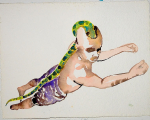Salman Rushdie once wrote, 'The consequence of the gift of self-consciousness, the gift that makes us human is the invention of self-image.' Ebenezer's recent set of watercolours explores his self-image about the burden of bearing the lightness and the heaviness of being an Indian. These are not self-portraits as one immediately imagines, but they are explorations of the self in reference to popular culture clichés, traditional settings, superhuman fantasies, and childhood dreams. Ebenezer would place his pictorial persona, a semblance of his photo, inside milieux that would problematize his sense of being in the world. Albatross, the distant seabird that is an evocation of the motherland, seeks to devour the persona of the artist in the first painting. It is also an allusion to Samuel Coleridge's The Rime of the Ancient Mariner, referring to the frustration and guilt that lead to the second painting of being shot at point blank range multiple times. Ebenezer's skill as a painter is evident in the Point Blank Shots where he uses the precise lines and chaotic textures of the watercolour medium to create a haunting approximation of a self-portrait. The watercolour's play of chance and emotion achieves Cézanne's flat-depth and anchors the other paintings in the series through a hidden narrative.
Ebenezer has stated that his visits to the Kanchipuram Kailasanathar temple, Gangaikondacholapuram and Darasuram had a profound impact on him as an artist, and he revisits those memories in his watercolours, Night Watch, and Prowl. In Night Watch , the corridors of Kailasanatha temple stand strangely illuminated, and a boy with a lantern stands stranded and stupefied in a corner. What is the meaning of the exquisite grandeur and the artistic achievement of the Kailasanathar temple for the contemporary generations? Do we have the same wonderment of an innocent boy with a lantern towards our artistic heritage? The persona of the boy becomes a tiger on the prowl standing on the liquefying pillars of Yali in another painting. Do we only prowl and smell our structures architectural heritage? The strangeness of the juxtaposition of the images of tiger and the pillars of Yali immediately brings forth the commonplace instinctual response we show towards pillars in the temples.
Is Ebenezer a conceptual and an intellectual artist? It appears so considering the conceptual play he engages in Fear Chemistry and Flower Power. In both the paintings, Ebenezer plays with the idea of Kundalini, the yogic power, being visualised as a snake. In Fear Chemistry the persona is floating upwards with a green snake replacing his spine and brain continuum. Very similar to the descriptions in the yogic literature the same snake blooms into a lotus in Flower Power. Perhaps there is a sequel in Little Prince where the boy sitting on the wall watches the snake trying to reach out to him. The title Little Prince is a direct reference to Antoine de Saint-Exupéry's classic novella in which the prince sees clearly with the heart what is invisible to the eyes. Mixed emotions characterise Ebenezer's reference to Saint-Exupéry's tale.
The narrator in Saint-Exupéry's novella explains that he once drew a picture of a boa constrictor with an elephant digesting in its stomach; however, every adult who saw the picture would mistakenly interpret it as a drawing of a hat. Only the little prince in the story is able to interpret it correctly. Perhaps Ebenezer invites his viewers to interpret his watercolours as if they were little princes untouched by the burdens of civilisation. Another piece of information that would help us to grasp Ebenezer's playfulness fully is that Saint-Exupéry used many watercolour illustrations to accompany his poetic tale of encounter between innocence and civilisation.
Indian civilisation, that is symbolised by the figures of elephants, almost drowns him as the painter swims to cross over from one stream to another. The elephants crawl over the spine of the swimming body in Stream to Stream. As a Superman, he can crush the elephants with his feet and use them as skating wheels for his feet and hands. However, the elephants define him as they stand as supporting pillars on both the sides of his head.
Ebenezer's conceptual art demands an interplay of his words and images, and its significance begins to grow in the minds of the viewers only when they keep looking at his pictures. For an artist who constantly strives to come to terms with his identity and heritage through a postmodernist pictorial language, it is a great accomplishment.














